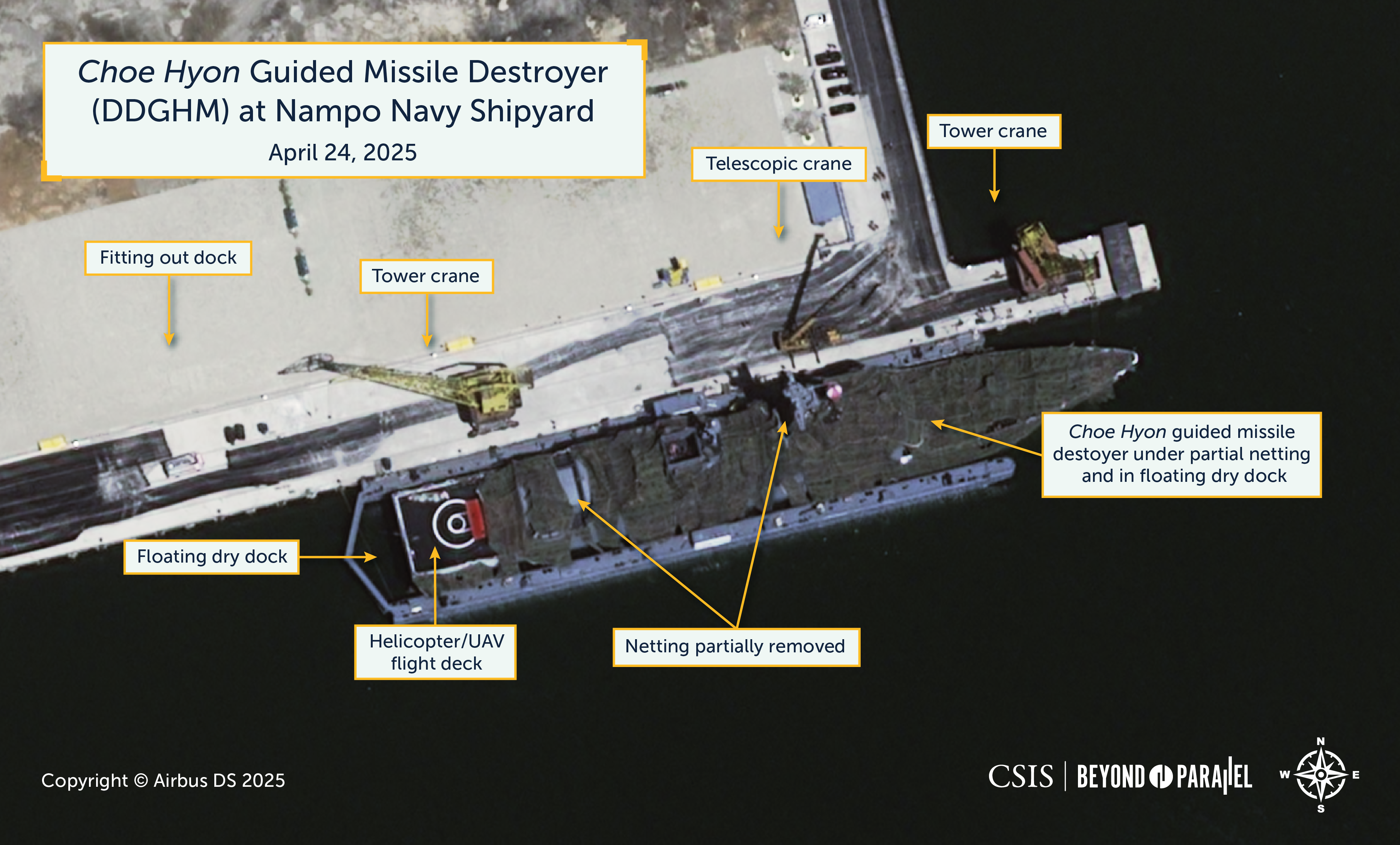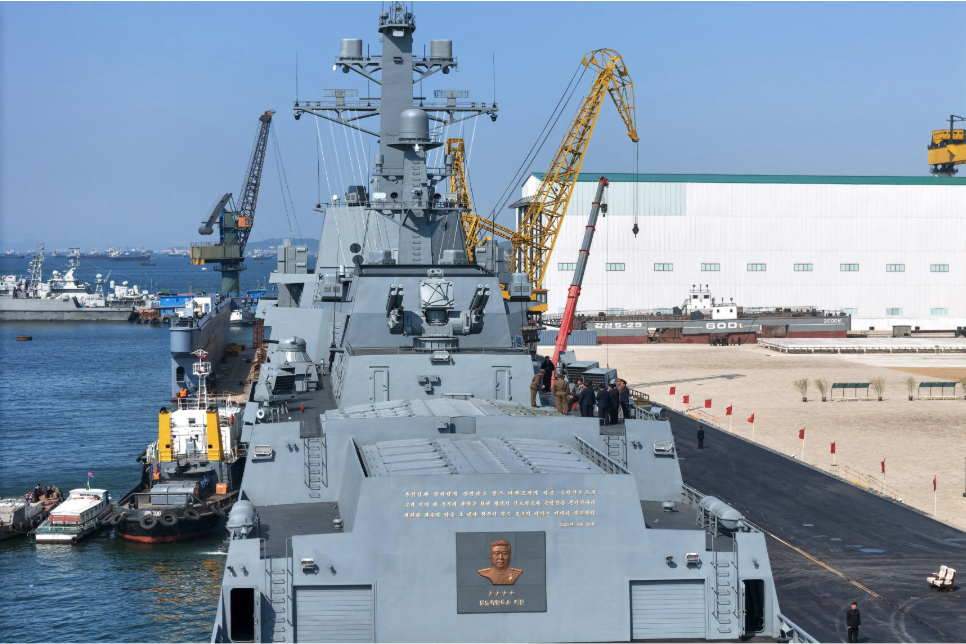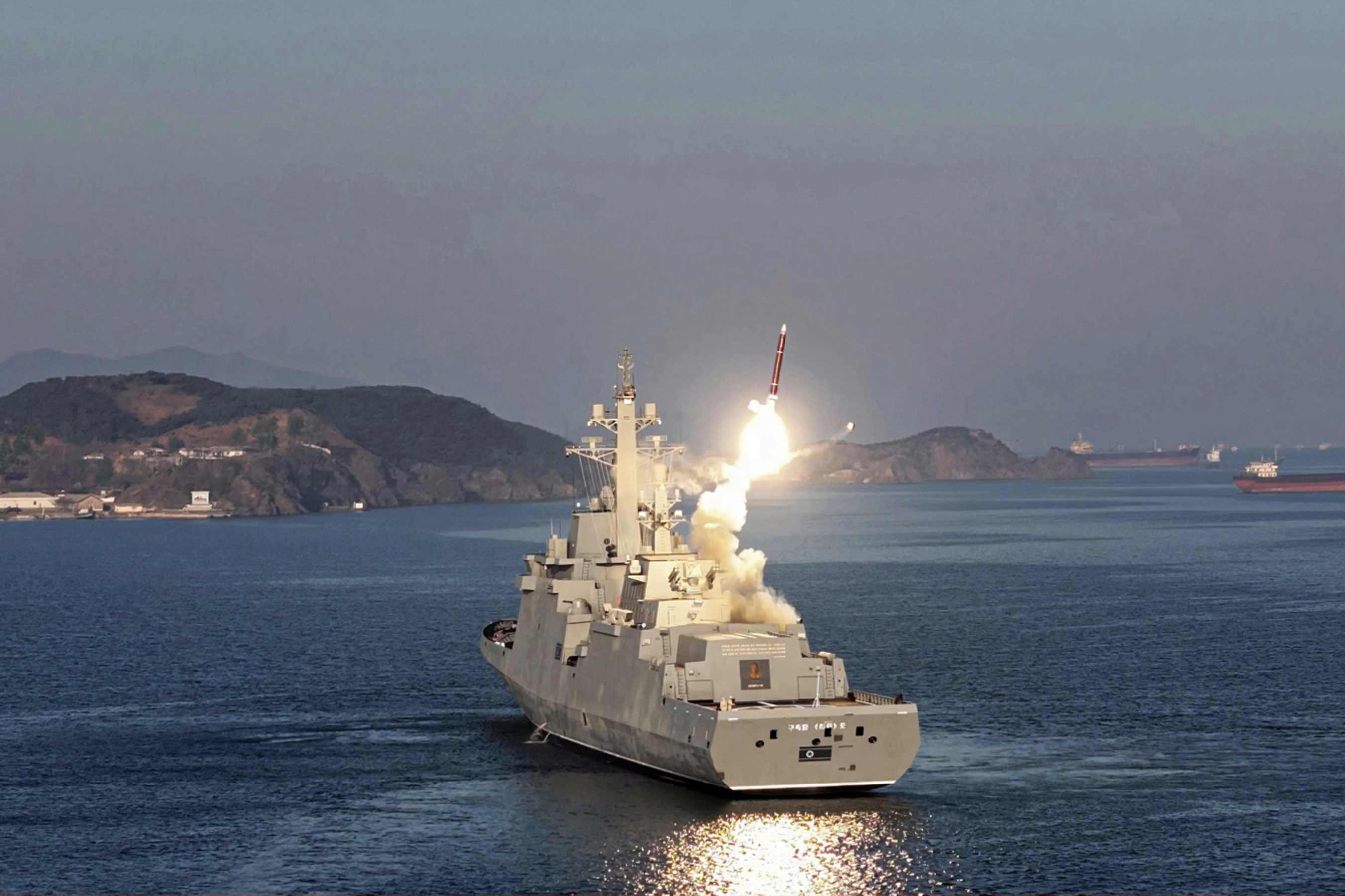
North Korea Launches the Choe Hyon Guided Missile Destroyer
Key Findings
- On April 25, North Korea launched the guided missile destroyer (DDGHM) Choe Hyon, from the Nampo commercial shipping port. This is the largest warship ever produced by North Korea and will serve as the lead vessel of the Korean People’s Navy’s first class of destroyers.
- Notably, the Choe Hyon‘s air defense system includes the Russian Pantsir-M, manifesting the growing cooperation between Pyongyang and Moscow.
- The new vessel also boasts anti-air, anti-ship, anti-submarine and anti-ballistic missile capabilities and is also capable of hypersonic strategic cruise missile and tactical ballistic missile strikes, according to North Korean leader Kim Jong-un’s statements.
- Should the design of the Choe Hyon be successful and lead to a new class of destroyers, these developments in conjunction with Kim’s aspiration for a cruiser and a nuclear-powered submarine will significantly augment a new naval threat to the Korean peninsula and the region for the U.S. and South Korea.
On April 25, North Korea launched the guided missile destroyer (DDGHM) Choe Hyon from the Nampo commercial shipping port.1 At approximately 144 meters long, this vessel is both one of the largest vessels ever produced within North Korea and the largest warship in Korean People’s Navy (KPN).2 Kim Jong-un described the Choe Hyon as a “powerful multi-mission destroyer” and the lead ship of a new class of destroyers.3 He also stated that “future [vessels of this class] will be named after the anti-Japanese revolutionary forerunners who distinguished themselves as renowned fighters and performed brilliant feats in the history of army building.4

Prior to the April 25 launch ceremony, the Choe Hyon was located within a floating dry dock along the Nampo Navy Shipyard’s fitting out dock. Between April 24 and 25, the netting that had previously covered the vessel was removed and the vessel was floated out of its floating dry dock and moved to the nearby commercial shipyard for the launch ceremony.

In keeping with Kim’s description, the vessel has all the characteristics of being the KPN’s most modern and capable warship. Available imagery indicates that it is armed with what appears to be several modern weapons systems that include:
- 44 vertical launch system (VLS) cells likely for surface-to-air missiles (SAMs),
- 30 larger VLS cells for cruise or surface-to-surface missiles,
- close in weapons systems (CIWS) for missile,
- UAV,
- anti-submarine defense,
- electronic warfare suites,
- 127mm main gun,
- and a helicopter/UAV flight deck.
While almost certainly not as capable, the Choe Hyon is similar in design to as the Chinese Peoples’ Liberation Army (PLAN) Type 055 DDGHM or Type 052D DDGHM, or the Republic of Korea Navy’s Sejong Daewang (KDX-III) class DDGHM.
Kim Jong-un stated that the Choe Hyon “is equipped not only with anti-air, anti-ship, anti-submarine and anti-ballistic missile capability but also with weapon systems for the most effective ground striking operations, like hypersonic strategic cruise missile, tactical ballistic missile and other means of strike. So it is capable of performing multi-mission surface operations and thus increasing the possibility of direct intervention by the Navy in the ground operations.”5
Notably, for the first time in North Korean service, the Choe Hyon‘s air defense system is the Russian Pantsir-M. It is unclear whether North Korea directly acquired the system or has obtained a license to produce the system from Russia. Pantsir systems are optimized for point defense against helicopters, UAVs, and cruise missiles. There is speculation that the land-based version of the Pantsir (Pantsir-S1/S2) system may, in the future, also be deployed around critical North Korean command, control, communications, computers, intelligence, surveillance, and reconnaissance (C4ISR) assets and with critical ground force units.


Three days after the ceremony, on April 28, North Korea conducted a range of missile launches of “supersonic cruise missiles, strategic cruise missiles, anti-aircraft missiles, and test firing of a 127mm shipboard automatic gun.”6 The test, which occurred closer to less than a nautical mile from the port, is likely more geared to serve a propaganda purpose than operational testing. Effective operational testing requires greater distances from the shore and a greater number of missile launches over an extended period of time.
The Choe Hyon is now back along the Nampo Navy Shipyard’s fitting out dock, where final fitting out and sailing preparations will be completed. It will likely then undergo a series of manufacturer’s trials and then be handed over to the KPN for acceptance trials. Following the successful completion of these trials, the Choe Hyon will enter operational service with the KPN.


Although Kim Jong-un stated in his speech that the vessel will operate as part of the KPN’s East Sea Fleet, it is likely that during service trials, the vessel will initially be based at the Pipagot Navy Base on the west coast and operate within the West Sea Fleet. A subsequent transfer of the Choe Hyon to the East Sea will necessitate a cruise around the Korean Peninsula—something not typically undertaken by the KPN.
Kim Jong-un added that the warship will be operational within the KPN “early next year” and that additional “new-type destroyers to be built in the future.”7 Should the design of the Choe Hyon be successful and lead to a new class of destroyers, these developments in conjunction with Kim’s aspiration for a cruiser and a nuclear-powered submarine will significantly augment a new naval threat to the Korean peninsula and the region for the U.S. and South Korea.
References
- Sources, including CSIS, previously identified this vessel as a guided missile frigate (FFG). The primary differences between a frigate and a destroyer center around capabilities. With destroyers being more heavily armed and equipped than frigates. Thus, they tend to be larger and possess greater range. DDGHM stands for a destroyer (DD) that carried guided missiles (G) and helicopter/UAV (H) which missiles are its primary armament (M). ↩
- The largest known vessel produced in North Korea is a 6,000 ton, 158-meter-long floating dry dock. The largest warships in the KPN are its two 1,500 ton, 102-meter-long Najin Class frigates (FFG). ↩
- “Respected Comrade Kim Jong Un’s Speech at Ceremony of Launching Destroyer of Navy of Korean People’s Army,” Rodong Sinmun, April 26, 2025. ↩
- Choe Hyon was a prominent member of what is call the “The first revolutionary generation” who fought as guerrillas against the Japanese during the colonial period. During the Korean War, Choe rose to prominence first as commander of the Korean Peoples’ Army 2nd Division and then as the commander of the II Corps. After the war he went on to serve as Minister of Defense. His son, Choe Ryong Hae, is currently Chairman of the Standing Committee of the Supreme People’s Assembly, and a top North Korean official. ↩
- Ibid. ↩
- “Combat Application Test of Weapon Systems of Multi-Mission Destroyer Choe Hyon Begins,” KCNA, April 30, 2025. ↩
- “Respected Comrade Kim Jong Un’s Speech at Ceremony of Launching Destroyer of Navy of Korean People’s Army,” Rodong Sinmun, April 26, 2025. ↩

